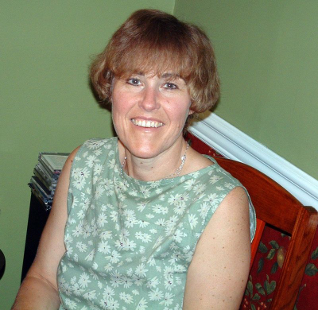 Katarzyna Otmianowska-Mazur (Photo courtesy of the Otmianowska-Mazur family
Katarzyna Otmianowska-Mazur (Photo courtesy of the Otmianowska-Mazur family
Katarzyna Otmianowska-Mazur
Contributed by Marian Soida
Professor Katarzyna Otmianowska-Mazur was born on November 16th, 1957 in Lublin. After graduating from the secondary school, she moved to Kraków and began astronomy studies at the Jagiellonian University, obtaining the master's degree in astronomy in 1981. In the same year, she was employed at the Astronomical Observatory of the Jagiellonian University as an assistant and initially dealt with the data base of minima of eclipsing binary stars and the Astronomical Almanac of the Jagiellonian University.
Her scientific interests have soon evolved towards the physics of galaxies and under the guidance of Prof. Marek Urbanik, she began research on the magnetism of the interstellar environment in spiral galaxies. Based on radio astronomy observations of galaxies, she developed her own numerical magnetohyrodynamical models. She summarized her works in her doctoral dissertation defended in 1993.
After her PhD, she continued her research work, creating well recognizable international group of scientists interested in numerical modeling of galaxies. She collaborated with world specialists in the field of plasma magnetohydrodynamic modeling, and has been one of the leaders of such research in the world. As a result of this work, numerous papers have been published. She also initiated famous series of international conferences on cosmic magnetism. After her habilitation (in 2004) she promoted three doctors who, under her supervision, became specialists in numerical modeling of magnetohydrodynamical processes. She was awarded with a few research grants which substantially increased the computing facility of Astronomical Observatory. In 2012, she obtained the title of professor of physical sciences.
She combined her research work with other duties. In 1999. she became the Deputy Director of the Astronomical Observatory of the Jagiellonian University for students. In the next two terms (2005-2012) she she has held the position of the Director of the Astronomcal Observatory of the Jagiellonian University. Her leadership led to significant strengthening of the scientific level of the Institute's research. Her efforts led to obtain financing of construction three Polish stations of the International LOFAR Telescope. As a result, with the end of 2015, Polish stations were included as part of this global European project with many significant scientific results.
Professor Katarzyna Otmianowska-Mazur was a member of the International Astronomical Union, International Union of Radio Sciences (Chairman of the Polish Radio Astronomy Committee) and the Polish Astronomical Society.
Professor Otmianowska-Mazur died on July 14, 2020.
Scientific and organizational achievements of our colleague, Professor Katarzyna Otmianowska-Mazur became an important legacy of the Astronomical Observatory, and its wise and nice person will always remain in our memory.
![[IAU logo]](iau_wb_thumb.jpg)
![[URSI logo]](URSI-logo-thumb.jpg)
![[Karl Jansky at his antenna]](jansky_photo_02_thumb.jpg)
![[Reber's Wheaton antenna]](Reber_Telescope_Wheaton_thumb.jpg)
![[Dover Heights]](Dover_Heights_02_thumb.jpg)
![[4C telescope]](GB61-195_4C_telescope_thumb.jpg)
![[Ewen and horn antenna]](ewen_horn1s.jpg)
![[Dwingeloo, 1956]](Dwingeloo-1956-thumb.jpg)
![[Jocelyn Bell Burnell and Cambridge antenna used in pulsar discovery]](burnell2_thumb.jpg)
![[Lovell Telescope at Jodrell Bank]](site_1594_0001-500-334-20180316163019-thumb150.jpg)
![[Wilson, Penzias, and Bell Labs horn antenna]](wilson-penzias-horn_thumb.jpg)
![[6-m Millimeter Radio Telescope in Mitaka, Japan]](6m-thumb.jpg)

